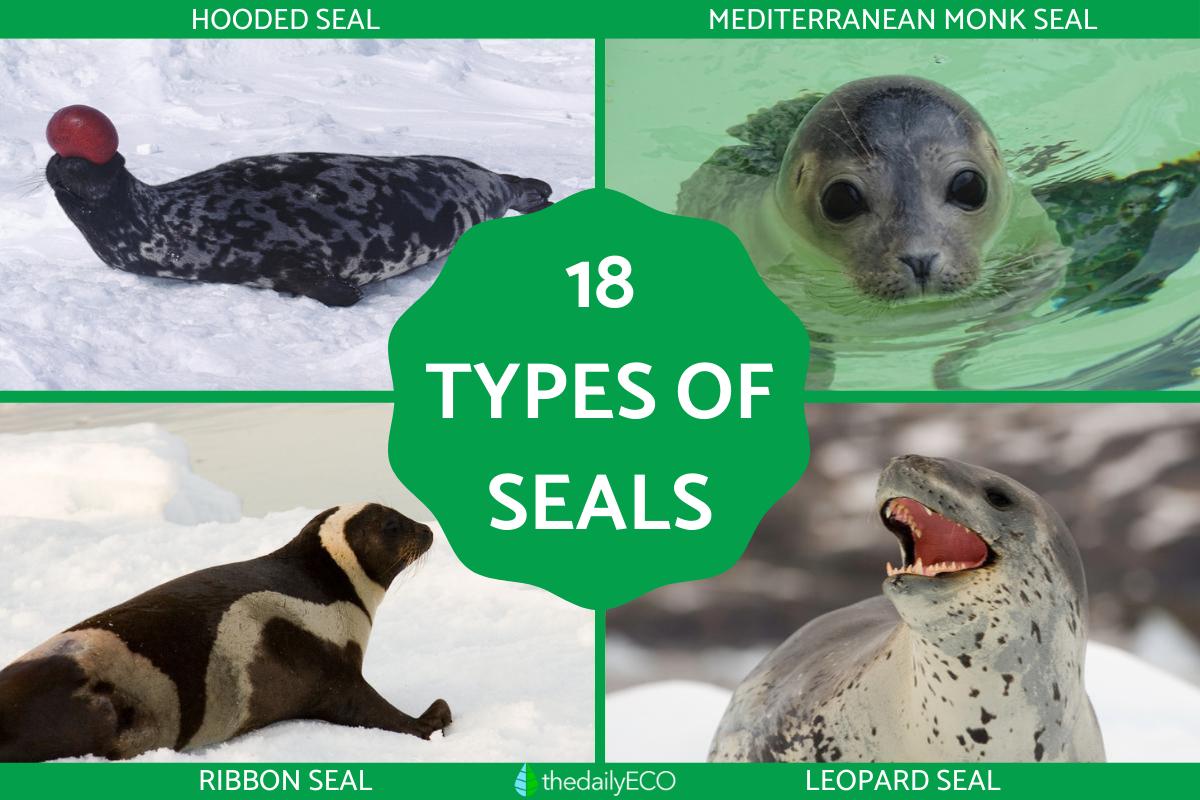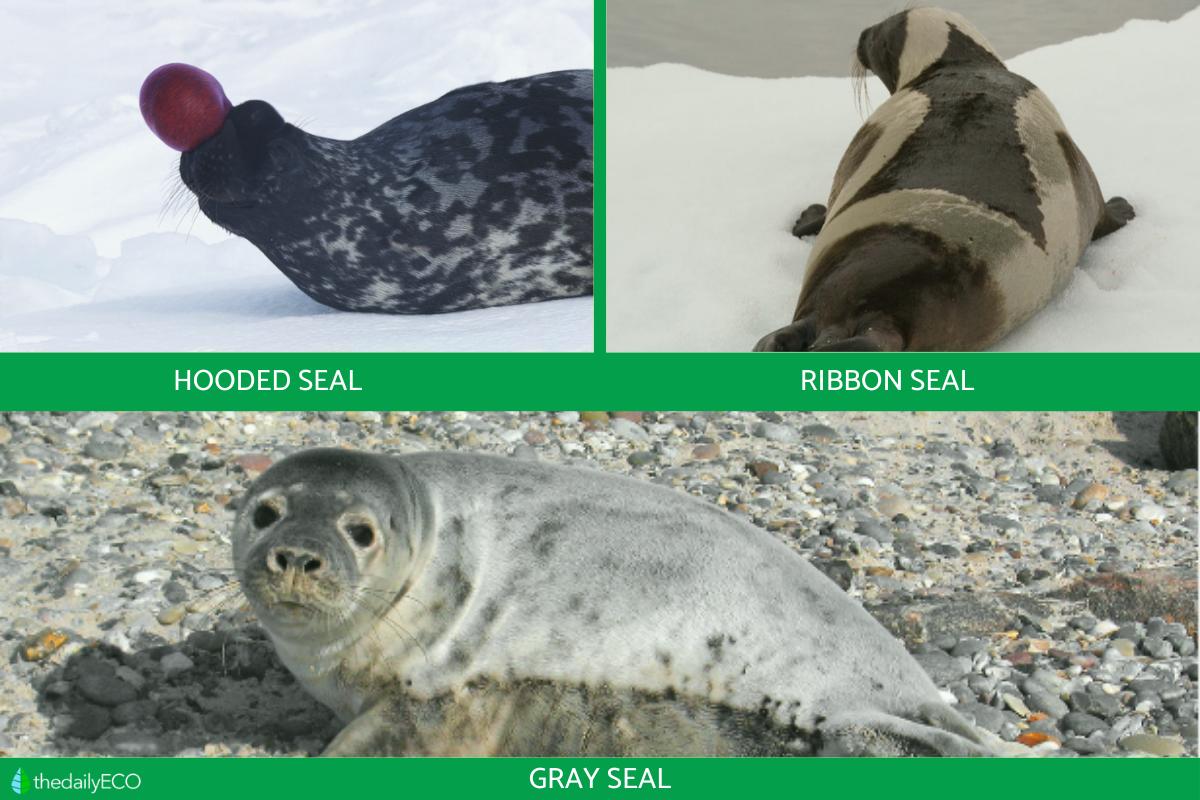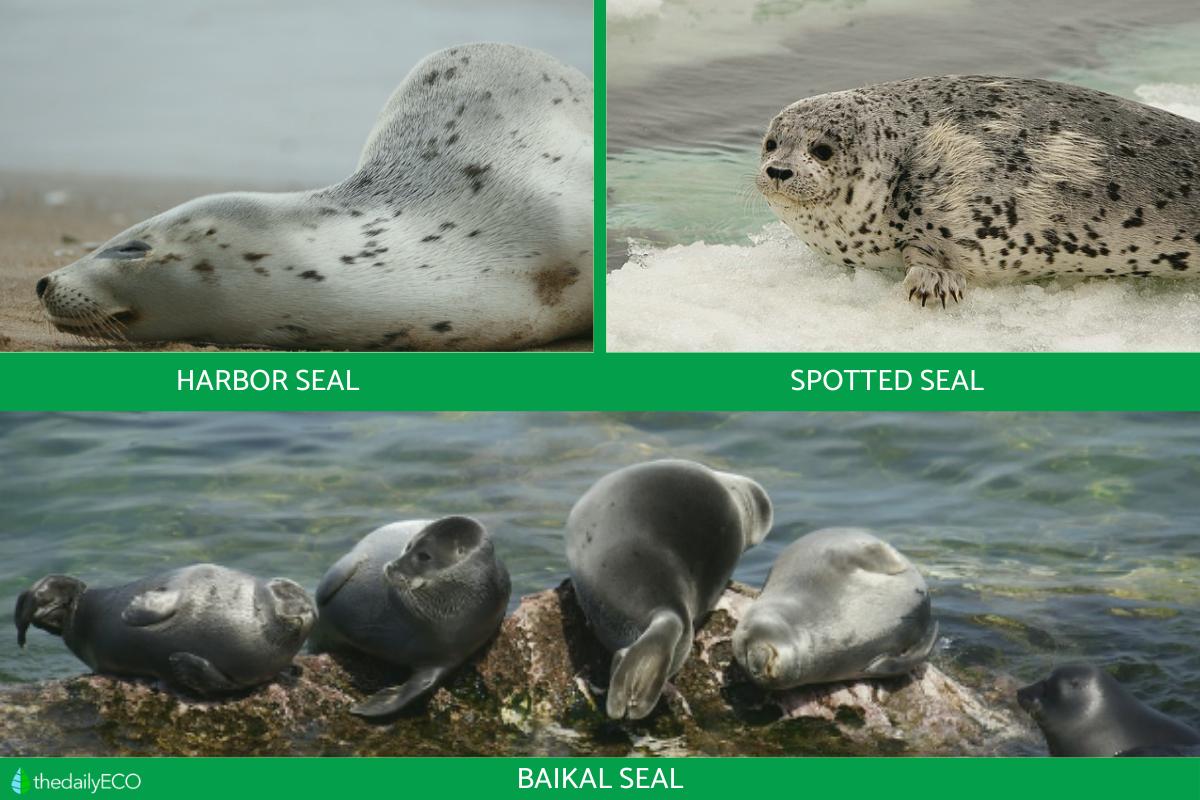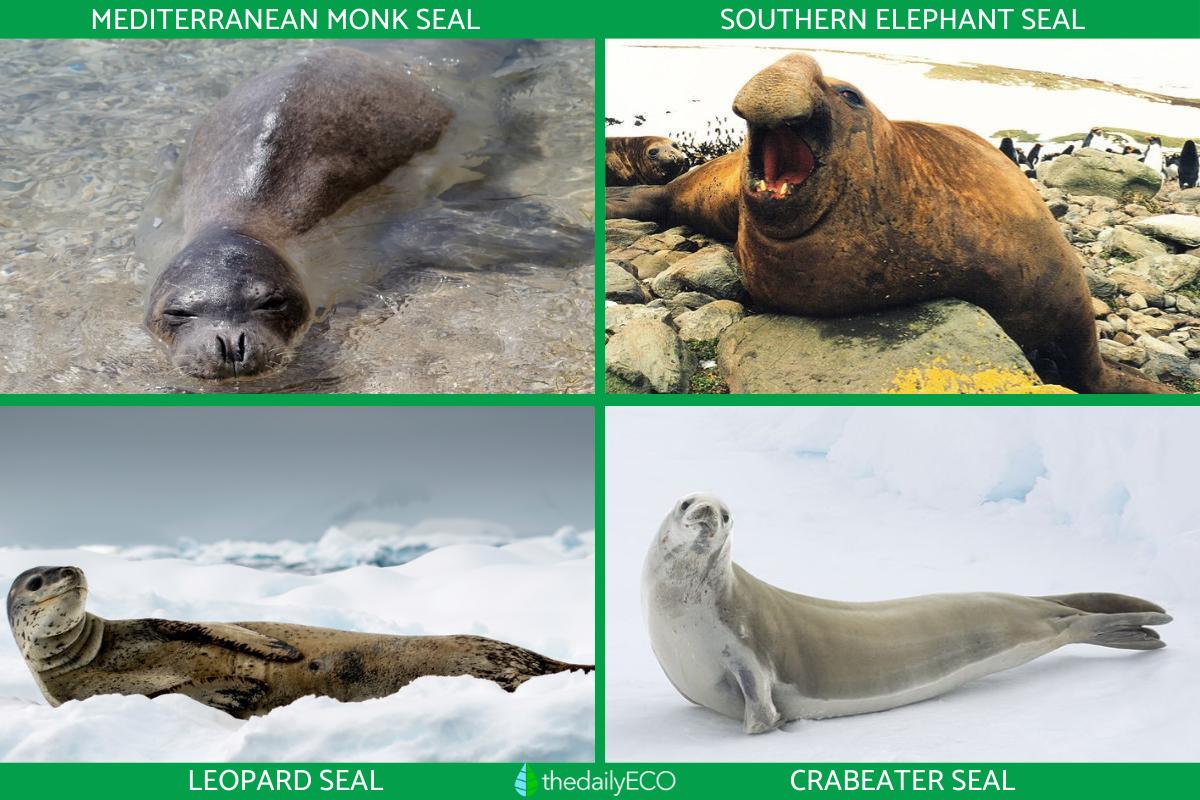Different Types of Seals


The group of animals known as seals are known scientifically as pinnipeds. These are semiaquatic mammals which have an almost global distribution. Included within this group are members of the families Otariidae and Odobenidae, known more commonly as eared seals and walruses, respectively. True seals are members of the family Phocidae. Instead of legs, these mammals have flippers, allowing them to be very agile in water, but somewhat clumsy on land. While they are themselves carnivorous, they are also prey to larger predators such as polar bears and orcas.
At thedailyECO, we share 18 different types of seals. While not an exhaustive list, it provides a good overview of the kinds of seals we can find across the world. In addition to explaining a little about their characteristics and behavior, we share photos of seals to get a better idea of what they are like.
Classification and characteristics of seals
Before we look at the different types of true seals, we need to look at how they are classified scientifically. Also known as earless seals or phocids, true seals are ranked taxonomically as follows:
- Kingdom: Animalia
- Phylum: Chordata
- Subphylum: Vertebrata
- Class: Mammalia
- Subclass: Theria
- Infraclass: Placentalia
- Order: Carnivora
- Suborder: Caniformia
- Clade: Arctoidea
- Clade: Pinnipedimorpha
- Family: Phocidae
Despite there being much diversity in terms of appearance and behavior, there are certain defining characteristics of true seals. They include the following:
- No ears: although they can hear, they lack an auricle or pinna, i.e. the visible part of the external ear.
- Flippers: the hind legs are modified into fins which act as swimming appendages. These are not functional for walking on land, but will help greatly in navigating the aquatic environment. The front limbs are able to support their weight when walking on land.
- Size: the weight of a seal varies depending on the species. The smallest ones weigh around 132 lb (60 kg), while the heaviest ones can weigh over 7,700 lb (3.5 metric tons).
- Diet: as with all other kinds of seal. true seals are carnivores. They feed using different strategies, depending on the species. For example, some suck in water to filter small crustaceans, while others bite their prey directly, such as fish and squid.
- Body: they have a hydrodynamic body to be able to swim very efficiently.
While all true seals belong to the family Phocidae, there are subfamilies within it to help us better understand the different kinds of seal we can find. These subfamilies determine where the seals live, differentiating between the northern and southern hemispheres. We learn more about individual true seal species in the sections below.
Northern seals (Subfamily Phocinae)
Since they live in northern continental areas, this subfamily is known as the northern seals. This group is characterized by having very developed claws on their front and back flippers. Many species are already extinct, but below we present some extant types of northern seals:
Hooded seal (Cystophora cristata)
Also known as the bladdernose seal, this type of seal is characterized by the fact that the males have a large and flexible nose which extends up to the top of its head. When deflated, it almost looks like a beret on some animals. When they want to attract a mate, they inflate a nasal bladder which blows up like a soccer ball. They have gray fur, with brown or black spots on it. They live in the Arctic Ocean, on and around Iceland, Norway and Greenland.
Ribbon seal (Histriophoca fasciata)
One of the most beautiful and unique seal species, this northern seal is found in the Arctic zone of the Pacific Ocean, specifically in the Sea of Okhotsk and the Bering Sea. Its common name derives from the distinct white stripes and markings which appear on their black body. You can see these very distinctive markings in the photo below.
Gray seal (Halichoerus grypus)
Also known as Atlantic seals or horsehead seals, they are gray with white patches. They are classified as large seals, measuring 6.6 to 9.8 ft (2 to 3 m) in length. There are two subspecies. They are H. grypus atlantica, which lives in the North Atlantic, and H. grypus grypus, which lives in the Baltic Sea.
Harbor seal (Phoca vitulina)
They are also known as common seals. They are grey to brown or whitish in color, with darker spots. They are large, measuring approximately 6.6 ft (2 m) in length. They are the seal species with the widest distribution range of all, as they live in the Pacific and Atlantic oceans.
Spotted seal (Phoca largha)
It is found in the North Pacific Ocean, as well as in nearby seas such as the Bering, Beaufort, North, Baltic, Bering and Okhotsk seas. Also known as the larga seal, it is medium-sized, measuring a maximum of 5-6.6 ft (1.5-2 m) in length. It has a snout similar in appearance to that of dogs.
Baikal seal or nerpa (Pusa sibirica)
It is one of the smallest true seals, measuring 3.3 to 5 ft (1 to 1.5 m) in length and lives only in Lake Baikal, Russia. They have dark fur and will change weight significantly throughout the year, depending on the amount of food they can eat. They also have the unique distinction of being the only extant freshwater true seal.
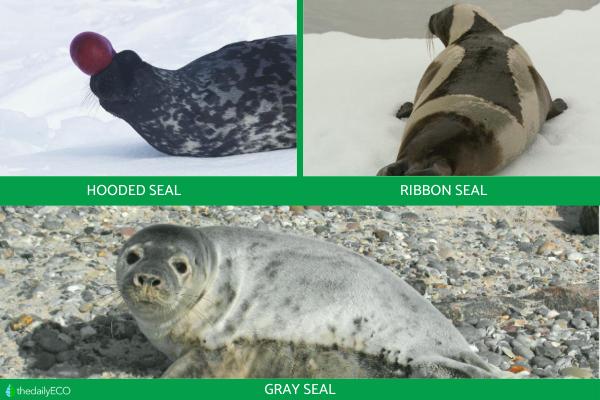

Southern seals (Subfamily Monachinae)
This subfamily constitutes the southern seals, so-called because they generally live in the southern hemisphere. They can be found in temperate, tropical and even polar climates. They are characterized by their considerably reduced rear claws.
Mediterranean monk seal (Monachus monachus)
Although they are a type of southern seal, they are actually are found in the Mediterranean. This shows that the designation of members of the subfamily Monachinae is generalized, since not all members live in the Southern Hemisphere. They are gray in color and measure 8.2 ft (2.5 m) in length. They have a white stripe on their abdomen and they are one of the last two species of monk seal that exist, the others are already being extinct.
Southern elephant seal (Mirounga leonina)
They are called elephant seals because they are quite large and have a large nose which almost looks like a stubby trunk. This large nose can be seen in the photo below. Males measure 16.4 ft (5 m) in length. They live in the Pacific Ocean, in populations distributed across an area ranging from Alaska to California.
Leopard seal (Hydrurga leptonyx)
Also sometimes referred to as the sea leopard, this is the second largest seal in Antarctica. It has a particularly streamlined shape, allowing them to be smooth operators in water. They hunt birds such as penguins and petrels, although they are also known to hunt other types of seals.
Crabeater seal (Lobodon carcinophaga)
It lives in Antarctica and feeds exclusively on krill. It measures up to 8.2 ft (2.5 m) in length. It is gray in color and turns almost completely white in winter. You can see its light pelt in the photo we share below.
Discover what are polar ecosystems in our related guide.
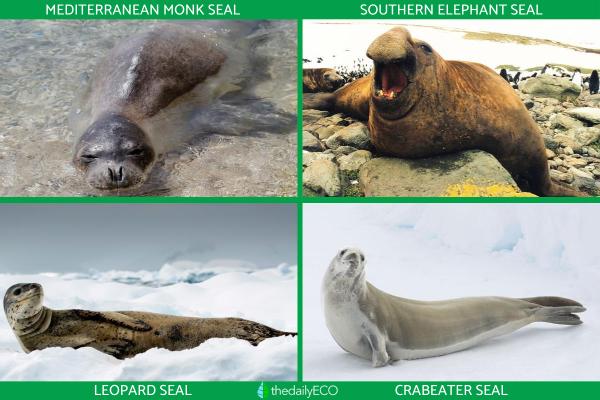
Other types of seals
The true seals we mentioned are some of the most popular or well-known types of seal, but there are other species to be found. Below we present the remaining members of the Phocidae family:
- Caspian seal (Pusa caspica)
- Ringed seal (Pusa hispida)
- Harp seal (Pagophilus groenlandicus)
- Hawaiian monk seal (Neomonachus schauinslandi )
- Ross seal (Ommatophoca rossii)
- Bearded seal (Erignathus barbatus )
- Northern elephant seal (Mirounga angustirostris )
- Weddell seal (Leptonychotes weddellii)
Learn about another type of aquatic mammal with our article on the different types of porpoises.
Types of seals in danger of extinction
As with many other types of aquatic mammal, many seal species face certain existential threats in their natural environments. Not all seal species are endangered, but there are some which are listed on the IUCN Red List of Threatened Species[1]. The following types of seals are under particular threat of extinction:
- Hooded seal (Cystophora cristata): vulnerable
- Ribbon seal (Histriophoca fasciata): near threatened
- Caspian seal (Pusa caspica): endangered
- Mediterranean monk seal (Monachus monachus): vulnerable
- Hawaiian monk seal (Neomonachus schauinslandi): threatened
While it is not always easy to pinpoint the exact reason for an animal's reduction in population numbers, there is clear evidence of human influence on a decline in numbers. Hunting for fat and skin has decimated certain seal populations. For example, the Caribbean monk seal (Neomonachus tropicalis) became extinct around 1952 due to hunting for their oil and meat.
Climate change is also having a drastic effect on seal populations, with warmer sea temperatures melting the ice floes on which they live and affecting their prey. Water pollution and other factors are also contributing to declining true seal populations.
You can learn more about how the habitat of seals is being affected with our article explaining the different types of sea ice.
If you want to read similar articles to Different Types of Seals, we recommend you visit our Wild animals category.
- IUCN Red List of Threatened Species. https://www.iucnredlist.org/
- Beatty, R., Beer, A., & Deeming, C. (2010). The Nature Book. Great Britain: Dorling Kindersley.





